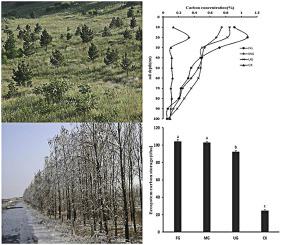Global Ecology and Conservation ( IF 4 ) Pub Date : 2021-01-06 , DOI: 10.1016/j.gecco.2020.e01438 Jiyou Yuan , Zhiyun Ouyang , Hua Zheng , Yirong Su

|
Global climate change and extensive socio-economic development both act to decrease the ground cover in the semi-arid sandy grasslands of Horqin district, northern China. Loss of ground cover increases the direct exposure of the surface soil to erosion by strong winds—a process that ultimately converts grassland into sandy desert. Three ways to restore such degraded lands through afforestation were evaluated in terms of total carbon stored in the restored ecosystems compared to that in the control. Total carbon comprised that stored in the biomass of trees, herbs, standing litter, and soil (to a depth of 100 cm). The three restoration treatments were (1) enclosing the grassland within a shelter belt of Populus × beijingensis (FG), (2) afforesting small but well-distributed patches within the grassland using Pinus sylvestris var. mongolica (MG), and (3) afforesting small but well-distributed patches within the grassland using Ulmus pumila (UG). A plot of desertified sandy grassland in which the dominant species were Agriophyllum squarrosum (Linn.) Moq. and Cenchrus echinatus Linn. was used as the control (CK). The results show that total ecosystem carbon storage in FG, UG, and MG increased significantly over time in comparison with that in CK. After more than 20 years, all three grassland restoration approaches are expected to contribute greatly to global ecosystem carbon sequestration. The rank order of total ecosystem carbon storage content is: FG (104.29 t/ha) > MG (102.96 t/ha) > UG (92.24 t/ha) > CK (24.48 t/ha). Soil carbon storage in the 0–30 cm and 0–50 cm depth ranges accounted for 41.81–60.13% and 59.42–80.80% of the total soil pool, respectively, across all treatments. FG had the highest biomass carbon storage, which was linked to differences in tree species. The structure of the plant community created in these treatments was different from that found in natural stands of forest and in grasslands without trees or shrubs. All the three treatments are suitable for the restoration of moderately desertified sandy grasslands in south-eastern Horqin, northern China, depending on the availability of water and soil nutrients. The results of the present study highlight the importance of degraded grassland restoration programs in enhancing ecosystem carbon storage.



























 京公网安备 11010802027423号
京公网安备 11010802027423号